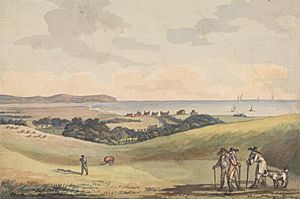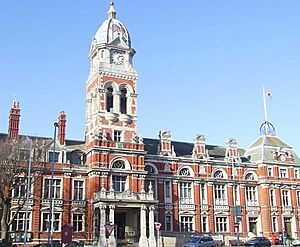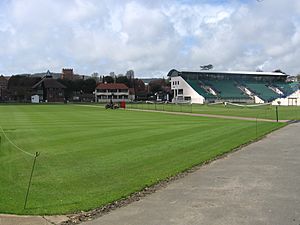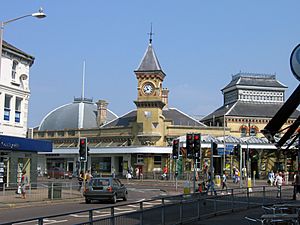Eastbourne facts for kids
Quick facts for kids
Eastbourne
Borough of Eastbourne
|
|
|---|---|
| Eastbourne | |
|
Beach huts on the front, the main railway station, historic bandstand, Sovereign Harbour, town hall and the pier
|
|
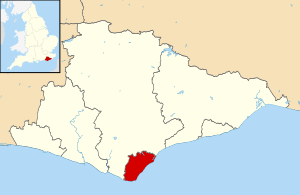 |
|
| Sovereign state | United Kingdom |
| Constituent country | England |
| Region | South East England |
| Non-metropolitan county | East Sussex |
| Status | Non-metropolitan district |
| Area | |
| • Total | 17.05 sq mi (44.16 km2) |
| Area rank | 281st (of 326) |
| Population
(2021 census)
|
|
| • Total | 101,689 |
| • Rank | 231st (of 326) |
| Ethnicity (2021) | |
| • Ethnic groups |
List
|
| Religion (2021) | |
| • Religion |
List
45.9% Christianity
43.2% no religion 6.7% not stated 2.2% Islam 0.7% other 0.6% Buddhism 0.5% Hinduism 0.2% Judaism 0.1% Sikhism |
| Time zone | UTC0 (GMT) |
| • Summer (DST) | UTC+1 (BST) |
| Postcodes |
BN20-23
|
| Area code(s) | 01323 |
| ONS code | 21UC (ONS) E07000061 (GSS) |
| OS grid reference | TV608991 |
| Website | Eastbourne Borough Council at |
Eastbourne is a town and seaside resort on the south coast of England, in East Sussex. It's about 19 miles (30 km) east of Brighton and 54 miles (87 km) south of London. Eastbourne is also a local government area with special "borough" status. It sits right next to Beachy Head, which has the tallest chalk sea cliff in Great Britain.
The seafront of Eastbourne is famous for its beautiful Victorian hotels. You'll also find a pier, a theatre, a modern art gallery, and a Napoleonic-era fort and military museum. Even though Eastbourne is a fairly new town, people have lived in this area since the Stone Age. The town became a popular tourist spot thanks to a rich landowner named William Cavendish. He hired an architect, Henry Currey, to design the town's layout. Currey got ideas from Europe, and the result is the lovely Victorian style you see today.
Eastbourne earns a lot of money from tourism. People visit for the traditional seaside fun, but also for conferences, events, and cultural sights. Other important jobs in Eastbourne are in trade, retail, healthcare, education, construction, and technology.
Eastbourne's population is growing. In 2021, about 101,689 people lived there. The town is attracting more students, families, and people who travel to London and Brighton for work.
Contents
- Eastbourne's Past: A Journey Through Time
- Ancient Times: From Stone Age to Celts
- Roman Era: Baths and Mysterious Discoveries
- Anglo-Saxon Era: The Stream and a Special Coin
- Norman Era: Domesday Book and a New Name
- Medieval Times: Markets and Royal Visits
- Georgian Era: Seaside Fun Begins
- Victorian Era: A Town is Born
- 20th Century: Wars and Modern Growth
- 21st Century: New Buildings and Events
- Eastbourne Local History Society
- Eastbourne's Geography: Cliffs, Downs, and Coastline
- How Eastbourne is Governed
- People of Eastbourne
- Eastbourne's Economy: Tourism and More
- Culture and Entertainment in Eastbourne
- Parks and Gardens: Green Spaces to Explore
- Sports in Eastbourne
- Famous Landmarks of Eastbourne
- Education in Eastbourne
- Religious Life in Eastbourne
- Getting Around Eastbourne
- Famous People from Eastbourne
- See also
Eastbourne's Past: A Journey Through Time
Eastbourne has a long and interesting history, stretching back thousands of years!
Ancient Times: From Stone Age to Celts
Long ago, in the Stone Age, people lived around Eastbourne. They left behind flint mines and tools in the Eastbourne Downs. A very important Bronze Age site was found in 1995 at Shinewater, near Hydneye lake. Around 500 BC, Celtic people are thought to have settled on the Eastbourne Downland.
Roman Era: Baths and Mysterious Discoveries
Underneath the modern town, you can find remains from the Roman times. There's a Roman bath and part of a pavement between Eastbourne Pier and the Redoubt Fortress. A Roman villa is also near the pier and the Queens Hotel.
In 1953, the bones of a woman who lived around 245 AD were found near Beachy Head. She was called the Beachy Head Lady. Scientists later found that she grew up in East Sussex but had family roots from Cyprus.
Anglo-Saxon Era: The Stream and a Special Coin
Around 963 AD, an old document from the Anglo-Saxon period mentions a landing place and a stream called 'Burne'. This stream gave Eastbourne its original name. Today, you can still see a small pond in Motcombe Gardens, which is all that's left of the 'Burne'. A statue of Neptune guards its bubbling source.
In 2014, a metal detectorist found a rare coin from the time of King Æthelberht II of East Anglia (who died in 794). This coin was a sign of independence and is a very important find for understanding England's history.
Norman Era: Domesday Book and a New Name
After the Normans took over England, the area of Eastbourne was owned by Robert, Count of Mortain, who was William the Conqueror's half-brother. The Domesday Book, a famous survey from 1086, mentions 'Borne' with farms, a church, a watermill, and places for fishing and making salt. The word 'East' was added to 'Borne' in the 13th century, giving the town its current name.
Medieval Times: Markets and Royal Visits
In 1315–16, the town was allowed to hold a weekly market, which helped local businesses. During the Middle Ages, two English kings, King Henry I and Edward II, visited Eastbourne. You can still see parts of Eastbourne's medieval past, like the 12th-century St Mary's Church and the old manor house called Bourne Place.
Bourne Place later became Compton Place and is now owned by the Duke of Devonshire. It's one of the two most important historic buildings in the town.
Georgian Era: Seaside Fun Begins
In 1752, a doctor named Richard Russell wrote about how good the seaside was for your health. This made places like Eastbourne very popular. Eastbourne became known as "the Empress of Watering Places" because of its health benefits.
Eastbourne's fame as a seaside resort grew when four of King George III's children visited for a summer holiday in 1780.
To protect against attacks from the French, Martello Towers were built along the coast between 1793 and 1807. Several of these towers still stand, including the Wish Tower, which is a famous landmark on the seafront. The Eastbourne Redoubt, a larger fortress, was also built around this time.
Before the 19th century, Eastbourne was just a few small villages. These included Bourne (now Old Town), Meads, South Bourne, and a fishing village called Sea Houses.
Victorian Era: A Town is Born
By the mid-1800s, most of the land belonged to two families: the Davies-Gilbert family and William Cavendish.
The arrival of the London, Brighton and South Coast Railway on May 14, 1849, really helped the town grow quickly. William Cavendish, now the 7th Duke of Devonshire, hired Henry Currey in 1859 to plan a whole new town. Eastbourne was designed to be a resort "for gentlemen by gentlemen." The town grew from less than 4,000 people in 1851 to almost 35,000 by 1891. In 1883, it became a municipal borough, and a special town hall was opened in 1886. This was a time of great growth and elegant development for Eastbourne.
20th Century: Wars and Modern Growth
During the First World War, a large hospital called Summerdown Camp opened in 1915 near the South Downs. It treated 150,000 injured soldiers, helping many of them return to duty.

The Second World War brought big changes. At first, children were sent to Eastbourne for safety, but after France fell in 1940, the town was expected to be an invasion target. Many people left, and empty buildings were used by the military. Thousands of Canadian soldiers stayed in Eastbourne from 1941 until D-Day. The town was heavily bombed, and many old buildings were damaged or destroyed. Eastbourne was called "the most raided town in the South East region."
After the war, Eastbourne continued to grow, with new housing areas like Hampden Park and Langney. In 1981, the Arndale Centre, an indoor shopping mall, was built in the town centre.
In the 1990s, a new area called the Crumbles was developed into Sovereign Harbour, a large marina with shops and thousands of homes. This area used to be home to many rare plants.
21st Century: New Buildings and Events
In 2009, the new Towner Gallery opened next to the Congress Theatre. Between 2016 and 2019, the Arndale Centre was completely updated and renamed The Beacon, adding a new Cineworld cinema.
In 2019, a fire broke out at the Claremont Hotel, causing significant damage.
Eastbourne Local History Society
The Eastbourne Local History Society was started in 1970. It's a group that helps people learn about the history of Eastbourne. They publish a journal called The Eastbourne Local Historian with over 1,500 articles. The current president of the society is William Cavendish, Earl of Burlington, whose family has long ties to the town.
Eastbourne's Geography: Cliffs, Downs, and Coastline
The South Downs are a big part of Eastbourne's landscape. You can see them from most of the town. These hills are made of chalk, formed long ago under the sea. You can see this chalk clearly along the coast at Beachy Head and the Seven Sisters, where the cliffs are white and steep. These cliffs are always changing due to erosion.
Some areas of the Downs, like Willingdon Down, are special because they have rare chalk grassland and ancient sites from the Stone Age. The coastline between Eastbourne and Seaford is also a protected area for its plants, animals, and geology. Many walking trails lead across the Downs to nearby villages and famous spots like Beachy Head.
Eastbourne's Neighbourhoods
Eastbourne's larger area includes the town of Polegate and villages like Willingdon and Jevington, Stone Cross, Pevensey, Westham, and Pevensey Bay. Inside Eastbourne itself, you'll find areas like:
- Langney: Shinewater, Kingsmere, Langney Village
- Hampden Park: Willingdon Trees, Ratton
- Inner areas: Rodmill, Ocklynge, Seaside, Roselands, Downside
- Town centre: Little Chelsea, Meads, Holywell, Old Town, Upperton
- Sovereign Harbour: North Harbour, South Harbour, Langney Point
There was once a community called Norway, which was a changed version of "North Way" because it was the route to the north. Today, only Norway Road and St Andrew's Church, Norway, remind us of this name.
The old fishing village of Holywell was located on a cliff ledge. It was taken over by the water board in 1896 to use the springs in the cliffs. Today, there's a pumping station, but most of the old village is gone due to cliff erosion.
Eastbourne's Climate: Lots of Sunshine!
Eastbourne has a maritime climate, meaning it has warm summers and mild winters, like the rest of the British Isles. It's known for getting a lot of sunshine! Eastbourne holds the UK record for the most sunshine in a month: 383.9 hours in July 1911. Temperatures usually stay mild, rarely going below freezing in many months.
| Climate data for Eastbourne 7 m asl, 1991–2020, Extremes 1960– | |||||||||||||
|---|---|---|---|---|---|---|---|---|---|---|---|---|---|
| Month | Jan | Feb | Mar | Apr | May | Jun | Jul | Aug | Sep | Oct | Nov | Dec | Year |
| Record high °C (°F) | 14.8 (58.6) |
14.7 (58.5) |
16.7 (62.1) |
24.0 (75.2) |
26.3 (79.3) |
29.0 (84.2) |
31.6 (88.9) |
30.4 (86.7) |
26.9 (80.4) |
21.4 (70.5) |
17.4 (63.3) |
15.2 (59.4) |
31.6 (88.9) |
| Mean daily maximum °C (°F) | 8.5 (47.3) |
8.6 (47.5) |
10.6 (51.1) |
13.3 (55.9) |
16.3 (61.3) |
18.9 (66.0) |
21.0 (69.8) |
21.3 (70.3) |
19.2 (66.6) |
15.7 (60.3) |
11.9 (53.4) |
9.3 (48.7) |
14.6 (58.2) |
| Mean daily minimum °C (°F) | 3.9 (39.0) |
3.6 (38.5) |
4.9 (40.8) |
6.7 (44.1) |
9.7 (49.5) |
12.5 (54.5) |
14.7 (58.5) |
14.9 (58.8) |
12.6 (54.7) |
9.9 (49.8) |
6.9 (44.4) |
4.5 (40.1) |
8.7 (47.7) |
| Record low °C (°F) | −9.7 (14.5) |
−8.8 (16.2) |
−6.1 (21.0) |
−1.7 (28.9) |
0.0 (32.0) |
3.3 (37.9) |
8.3 (46.9) |
7.1 (44.8) |
5.2 (41.4) |
0.1 (32.2) |
−3.7 (25.3) |
−7.8 (18.0) |
−9.7 (14.5) |
| Average precipitation mm (inches) | 83.1 (3.27) |
58.9 (2.32) |
47.6 (1.87) |
44.4 (1.75) |
46.1 (1.81) |
46.8 (1.84) |
54.1 (2.13) |
59.8 (2.35) |
59.9 (2.36) |
93.2 (3.67) |
98.5 (3.88) |
100.1 (3.94) |
792.5 (31.19) |
| Average rainy days (≥ 1.0 mm) | 12.7 | 10.4 | 8.7 | 7.9 | 7.9 | 6.8 | 7.3 | 8.4 | 8.5 | 11.5 | 13.0 | 13.1 | 116.2 |
| Mean monthly sunshine hours | 70.1 | 89.6 | 134.2 | 202.2 | 235.1 | 237.7 | 251.5 | 232.7 | 176.3 | 121.6 | 78.3 | 62.5 | 1,891.8 |
| Source 1: Met Office | |||||||||||||
| Source 2: Royal Dutch Meteorological Institute/KNMI | |||||||||||||
How Eastbourne is Governed
Eastbourne has two main levels of local government. The Eastbourne Borough Council handles local services and is based at the Eastbourne Town Hall. The East Sussex County Council, based in Lewes, provides county-wide services.
Eastbourne became a "municipal borough" in 1883, which meant it had its own town council. One of the first things the new council did was build the impressive Eastbourne Town Hall, which opened in 1886.
Eastbourne in Parliament
The Parliament Constituency of Eastbourne covers the borough and the nearby area of Willingdon. Eastbourne is currently represented by a Member of Parliament (MP) from the Liberal Democrats.
People of Eastbourne
Eastbourne is the second largest district in East Sussex. In 2021, its population was about 101,700 people. The town's population has been growing, and the average age of residents has become younger. This is because more students, families, and people who work in London or Brighton are moving to Eastbourne.
Most people in Eastbourne are from a White background (90.8% in 2021), with 82.4% born in England. There are also people from other countries, including Poland and Portugal.
Eastbourne has a good job market, with unemployment rates often lower than the national average. More people are also getting higher education qualifications.
Eastbourne's Economy: Tourism and More
Eastbourne's economy is growing, with a population of over 100,000. The Sovereign Harbour area, which is Britain's largest marina, has added many new homes and businesses.
Eastbourne has many different types of companies. The Chamber of Commerce, with over 500 members, helps local businesses connect.
Tourism: A Big Part of Eastbourne

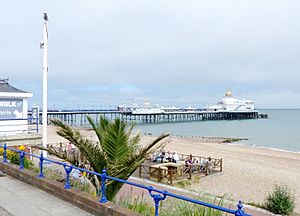
Eastbourne's seafront is famous for its Victorian hotels, pier, and bandstand. These help keep the area looking classic and beautiful. The Duke of Devonshire still owns the seafront buildings and makes sure they stay as hotels, not shops.
The town has a 4-mile (6 km) shingle beach, stretching from Sovereign Harbour to Beachy Head. Visitors love the beach and seafront.
There are many fun things to do, including swimming pools, fitness centres, and sports clubs like scuba diving. For kids, there's an adventure park, crazy golf, and go-karting. The pier is a popular spot and sometimes hosts events like the international birdman competition.
A very popular event is Eastbourne Airbourne, a large air show held every August. Tourism brings in a lot of money for Eastbourne, supporting thousands of jobs.
Major Employers
One of Eastbourne's biggest employers is Gardners Books, the UK's largest book wholesaler. They employ many people in packing and shipping books from their huge warehouse.
Most jobs in Eastbourne come from small private businesses. However, Eastbourne District General Hospital is also a very important public sector employer.
Culture and Entertainment in Eastbourne
Eastbourne has a lively cultural scene with art, theatre, music, and festivals.
Towner Art Gallery
The Towner Art Gallery is Eastbourne's main art gallery. It moved to a new building next to the Congress Theatre in 2009. The gallery has one of the most important public art collections in southern England. It even hosted the famous Turner Prize in 2023!
Theatres: A Stage for Everyone
Eastbourne has several theatres. The Congress Theatre, the Devonshire Park Theatre, and the Winter Garden are owned by the council. The Royal Hippodrome Theatre is now run by a charity.
The Devonshire Park Theatre is a beautiful example of a Victorian theatre. It hosts plays, comedies, and a yearly local pantomime. The Royal Hippodrome has the longest-running summer show in Britain. The London Philharmonic Orchestra often performs at the Congress Theatre.
There are also smaller theatres like the Underground Theatre and the Lamb Theatre.
Cinemas: Catch a Movie
Eastbourne has a large Multiplex cinema called Cineworld, with eight screens, located in The Beacon shopping centre.
Festivals and Fairs: Fun for All Ages
Many cultural events happen in Eastbourne every year.
- Airbourne, Eastbourne's International Airshow, is one of the most popular airshows in the UK.
- The Eastbourne Music & Arts Festival, now called Eastbourne Performing Arts Festival, has been held since 1961.
- Eastbourne Feastival is a family festival with food, music, and culture.
- Crossing The Screen International Film Festival is Eastbourne's longest-running film festival.
- The Eastbourne Steampunk Festival celebrates retro-futuristic technology.
- The Eastbourne Vintage Festival is held in Gildredge Park.
- The Springwater Festival celebrates water along the seafront.
Music Venues: Live Sounds
The Eastbourne Bandstand on the seafront hosts many concerts, including firework concerts, rock nights, and tribute bands.
Grove Road has independent record shops and a venue called Printer's Playhouse, which features live music and new plays.
Local Media
Seahaven FM on 95.6 FM is the local radio station for Eastbourne. You can also listen to More Radio Eastbourne and Storm FM UK (online only). Regional news is covered by BBC South East Today and ITV News Meridian.
Eastbourne has a weekly newspaper called The Eastbourne Herald. There's also a monthly free newspaper called Eastbourne News.
Parks and Gardens: Green Spaces to Explore
Eastbourne has many beautiful parks and gardens.
- Hampden Park was the first public park, opened in 1902. It has football pitches, a rugby club, a large lake, a cafe, playgrounds, tennis courts, and a BMX and skate park.
- Shinewater Park is the largest and newest park, opened in 2002. It has a fishing lake, basketball courts, football pitches, a BMX and skate park, and a playground.
- Gildredge Park is a big open park between the town centre and Old Town. It's popular with families and has a playground, cafe, tennis courts, and bowls lawns. The smaller Manor Gardens next to it has a lovely rose garden.
- Princes Park is at the eastern end of the seafront. It has a playground with a paddling pool, a cafe, and a large lake known for its swans. The lake is used for water sports like kayaking and windsurfing.
- Devonshire Park is home to the famous ladies tennis championships.
- Other parks include Helen Gardens, the Italian Gardens, Sovereign Park, and Motcombe Gardens.
Eastbourne is known for its beautiful floral displays, especially the Carpet Gardens along the coast. The town has won awards for its displays in the 'Britain in Bloom' competition.
Sports in Eastbourne
Eastbourne is a great place for sports!
- Tennis: Devonshire Park hosts the Eastbourne International, a big tennis tournament that prepares players for Wimbledon.
- Football: Eastbourne has three main football clubs: Eastbourne Borough F.C. (playing in the National League South), Eastbourne Town F.C. (Isthmian League South East Division), and Eastbourne United Association F.C. (Southern Combination League Premier).
- Speedway: The Eastbourne Eagles are a speedway club that races at Arlington Stadium, just outside town. They were champions in 2000.
- Netball: Eastbourne was the location of the very first Netball World Cup in 1963.
- Triathlon: The town has hosted a triathlon, attracting both professional and amateur athletes.
- Other sports include cricket, hockey, rugby, lacrosse, and golf. There's also an annual extreme sports festival on the seafront. The Eastbourne Sovereign Sailing Club offers dinghy sailing.
Famous Landmarks of Eastbourne
Beachy Head and the Downs
The Eastbourne Downland is a stunning natural area behind the town. The town of Eastbourne owns these 4,000 acres of farmland and downland to protect their beauty forever.
The famous lighthouse at the bottom of the cliff started working in October 1902. Before that, the Belle Tout Lighthouse on top of the cliff warned ships. Belle Tout is now a private home and was even moved back from the cliff edge in 1999 to save it from falling into the sea!
Eastbourne Pier
Eastbourne Pier was built between 1866 and 1872. It's about 300 metres (1000 ft) long and is built on stilts that allow it to move in rough weather. It has a theatre, a bar, and a camera obscura.
Eastbourne Pier Fire
On July 30, 2014, a fire badly damaged about one-third of the pier. Firefighters worked hard to put it out. The government gave Eastbourne Borough Council £2 million to help the town recover from the loss of this popular attraction.
Eastbourne Redoubt
The Eastbourne Redoubt is a historic fortress built in the early 1800s to defend against a possible invasion by Napoleon's forces. Today, it's a museum with collections from different military regiments, including old vehicles and medals.
Education in Eastbourne
Eastbourne has long been known for its schools. In the 19th century, many independent schools were set up here. However, over time, many of these schools closed, especially after the Second World War.
Today, Eastbourne has three independent schools: St. Andrew's Prep, Eastbourne College, and Bede's School.
For state education, there are 6 secondary schools, 17 primary schools, and 3 special schools. Parts of the University of Brighton are also located in Eastbourne. Many students from other countries come to Eastbourne to study English at its language colleges.
East Sussex College is a large college that offers courses for students aged 16 and older, including GCSEs, A Levels, and vocational programs.
Religious Life in Eastbourne
Eastbourne has many places of worship for different faiths. The medieval parish church of St Mary in Old Town is one of the oldest. Other notable churches include the redbrick St Saviour's and St Peter's and the Catholic Church of Our Lady of Ransom.
There is also a Greek Orthodox Church, a Strict Baptist Chapel, and a United Reformed Church. The town has a Jewish community and a small mosque for the Islamic community.
Getting Around Eastbourne
Eastbourne is connected by roads like the A22 to London and the A27 to Brighton and Hastings. It's one of the largest towns in Britain without a direct dual-carriageway link to the main motorway network.
Most people in Eastbourne use cars, but the local council wants to encourage more bus use. Bus services are provided by Stagecoach Group and Brighton & Hove, connecting Eastbourne to nearby towns and cities. You can also take a National Express coach to London.
The main railway station is in the town centre. Southern trains run regularly to London Victoria, Gatwick Airport, Hastings, and Ashford International. The journey to London Victoria takes about 1 hour and 36 minutes.
Famous People from Eastbourne
Eastbourne has been home to, or visited by, many interesting and famous people!
Writers and Thinkers
- Lewis Carroll, who wrote Alice in Wonderland, holidayed in Eastbourne 19 times.
- Novelist Angela Carter was born here.
- Charles Webb, who wrote The Graduate, lived and died in Eastbourne.
- Famous writer George Orwell went to school in Eastbourne.
- Philosophers Karl Marx and Frederick Engels often stayed in the area. Engels' ashes were scattered off Beachy Head.
Musicians
- Composer Claude Debussy finished his famous piece La mer at the Grand Hotel.
- Pianist Russ Conway lived here for many years.
- David Bowie performed in Eastbourne several times and even mentioned the town in a song!
- Bands like Toploader and Easyworld formed in Eastbourne.
Scientists and Explorers
- Frederick Gowland Hopkins, a Nobel Prize-winning biochemist, was born in Eastbourne.
- Michael Fish, the famous BBC weather forecaster, was born and studied here.
- NASA engineer Bruce Woodgate designed a key part of the Hubble Space Telescope.
- Polar explorer Lawrence Oates and mountaineer George Mallory both attended schools in Eastbourne.
- Ernest Shackleton, another Antarctic explorer, lived here.
Artists and Performers
- Artist Eric Ravilious grew up, was educated, and taught in Eastbourne.
- Comedian Ronald Frankau died in Eastbourne.
- Actors like Eddie Izzard, Prunella Scales, and Ed Speleers attended school in Eastbourne.
Politicians and Others
- Theresa May, a former Prime Minister of the United Kingdom, was born in Eastbourne.
- Three brave soldiers who received the Victoria Cross (the highest military award) died in Eastbourne.
- Douglas Bader, a famous Second World War fighter pilot who flew despite losing both legs, went to school here.
- Henry Allingham, who was briefly the world's oldest man, lived in Eastbourne.
- British tennis star Johanna Konta is also from Eastbourne.
Many buildings in Eastbourne have special blue plaques to show where famous people lived or worked.
|
See also
 In Spanish: Eastbourne para niños
In Spanish: Eastbourne para niños










